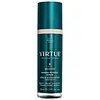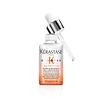What's inside
What's inside
 Key Ingredients
Key Ingredients

 Benefits
Benefits

 Concerns
Concerns

 Ingredients Side-by-side
Ingredients Side-by-side

Water
Skin ConditioningC13-15 Alkane
SolventCoconut Alkanes
EmollientPropanediol
SolventGlycerin
HumectantAmmonium Acryloyldimethyltaurate/Vp Copolymer
Salvia Hispanica Seed Extract
EmollientKeratin
Skin ConditioningPolyglyceryl-3 Methylglucose Distearate
EmulsifyingSqualane
EmollientQuercus Petraea Fruit Extract
Skin ConditioningCopper Tripeptide-34
Skin ConditioningPalmitoyl Dipeptide-52
Skin ConditioningCitrus Paradisi Fruit Extract
Skin ConditioningCamellia Sinensis Leaf Extract
AntimicrobialPanthenol
Skin ConditioningArginine
MaskingHydrolyzed Vegetable Protein
Skin ConditioningLinum Usitatissimum Seed Extract
PerfumingQuaternium-95
UV AbsorberHydrogenated Olive Oil Unsaponifiables
EmollientOryza Sativa Extract
AbsorbentCaesalpinia Spinosa Fruit Pod Extract
Lauryl Glucoside
CleansingJojoba Esters
EmollientPolyglyceryl-6 Laurate
EmulsifyingShea Butter Ethyl Esters
EmollientHydrogenated Ethylhexyl Olivate
EmollientMyristyl Glucoside
CleansingCoco-Caprylate/Caprate
EmollientTremella Fuciformis Polysaccharide
Emulsion StabilisingOryza Sativa Bran Water
MaskingCentella Asiatica Extract
CleansingEthylhexylglycerin
Skin ConditioningHydroxypropyltrimonium Hydrolyzed Rice Protein/Siloxysilicate
Helianthus Annuus Seed Oil
EmollientPolyglyceryl-10 Laurate
Skin ConditioningPhospholipids
Skin ConditioningHydrolyzed Linseed Seed
HumectantSodium Dilauramidoglutamide Lysine
HumectantPopulus Tremuloides Bark Extract
AntiseborrhoeicTocopherol
AntioxidantRosmarinus Officinalis Leaf Extract
AntimicrobialOryza Sativa Bran Extract
Skin ConditioningItaconic Acid
AntimicrobialSodium Phytate
Oryza Sativa Seed Protein
AntioxidantXylitol
HumectantPhytic Acid
Citric Acid
BufferingCaprylyl Glycol
EmollientHelianthus Annuus Sprout Extract
Skin ConditioningCalcium Gluconate
HumectantCaprylic Acid
CleansingParfum
MaskingGalactoarabinan
Gluconolactone
Skin ConditioningTrehalose
HumectantMaltodextrin
AbsorbentLeuconostoc/Radish Root Ferment Filtrate
AntimicrobialPhenoxyethanol
PreservativeChlorphenesin
AntimicrobialSodium Hydroxide
BufferingSodium Benzoate
MaskingSodium Phosphate
BufferingPotassium Sorbate
PreservativeBenzyl Salicylate
PerfumingCoumarin
PerfumingLimonene
PerfumingGeraniol
PerfumingHexyl Cinnamal
PerfumingLinalool
PerfumingWater, C13-15 Alkane, Coconut Alkanes, Propanediol, Glycerin, Ammonium Acryloyldimethyltaurate/Vp Copolymer, Salvia Hispanica Seed Extract, Keratin, Polyglyceryl-3 Methylglucose Distearate, Squalane, Quercus Petraea Fruit Extract, Copper Tripeptide-34, Palmitoyl Dipeptide-52, Citrus Paradisi Fruit Extract, Camellia Sinensis Leaf Extract, Panthenol, Arginine, Hydrolyzed Vegetable Protein, Linum Usitatissimum Seed Extract, Quaternium-95, Hydrogenated Olive Oil Unsaponifiables, Oryza Sativa Extract, Caesalpinia Spinosa Fruit Pod Extract, Lauryl Glucoside, Jojoba Esters, Polyglyceryl-6 Laurate, Shea Butter Ethyl Esters, Hydrogenated Ethylhexyl Olivate, Myristyl Glucoside, Coco-Caprylate/Caprate, Tremella Fuciformis Polysaccharide, Oryza Sativa Bran Water, Centella Asiatica Extract, Ethylhexylglycerin, Hydroxypropyltrimonium Hydrolyzed Rice Protein/Siloxysilicate, Helianthus Annuus Seed Oil, Polyglyceryl-10 Laurate, Phospholipids, Hydrolyzed Linseed Seed, Sodium Dilauramidoglutamide Lysine, Populus Tremuloides Bark Extract, Tocopherol, Rosmarinus Officinalis Leaf Extract, Oryza Sativa Bran Extract, Itaconic Acid, Sodium Phytate, Oryza Sativa Seed Protein, Xylitol, Phytic Acid, Citric Acid, Caprylyl Glycol, Helianthus Annuus Sprout Extract, Calcium Gluconate, Caprylic Acid, Parfum, Galactoarabinan, Gluconolactone, Trehalose, Maltodextrin, Leuconostoc/Radish Root Ferment Filtrate, Phenoxyethanol, Chlorphenesin, Sodium Hydroxide, Sodium Benzoate, Sodium Phosphate, Potassium Sorbate, Benzyl Salicylate, Coumarin, Limonene, Geraniol, Hexyl Cinnamal, Linalool
Isododecane
EmollientDimethicone
EmollientDimethiconol
EmollientTocopherol
AntioxidantGlyceryl Linoleate
EmollientZea Mays Germ Oil
EmollientGlyceryl Oleate
EmollientLinalool
PerfumingHydroxycitronellal
PerfumingBenzyl Salicylate
PerfumingBenzyl Alcohol
PerfumingHexyl Cinnamal
PerfumingCitronellol
PerfumingAlpha-Isomethyl Ionone
PerfumingGlyceryl Linolenate
EmollientCoumarin
PerfumingLimonene
PerfumingParfum
MaskingIngredients Explained
These ingredients are found in both products.
Ingredients higher up in an ingredient list are typically present in a larger amount.
Benzyl Salicylate is a solvent and fragrance additive. It is an ester of benzyl alcohol and salicylic acid. This ingredient can be naturally found in some plants and plant extracts.
In fragrances, Benzyl Salicylate may be a solvent or a fragrance component. In synthetic musk scents, it is used as a solvent. For floral fragrances such as lilac and jasmine, it is used as a fragrance component. The natural scent of Benzyl Salicylate is described as "lightly-sweet, slightly balsamic".
While Benzyl Salicylate has been associated with contact dermatitis and allergies, emerging studies show it may not be caused by this ingredient alone.
However, this ingredient is often used with fragrances and other components that may cause allergies. It is still listed as a known allergen in the EU. We recommend speaking with a professional if you have concerns.
Another study from 2021 shows Benzyl Salicylate may have anti-inflammatory properties.
Learn more about Benzyl SalicylateCoumarins are a group of substances found naturally in plants. There are over 1300 types of coumarins identified. It has a natural vanilla scent.
Coumarin is an identified EU known allergy, meaning it may cause an allergic reaction when applied to the skin.
In many countries, coumarin is banned as a food additive. However, it can be found in soaps, tobacco products, and some alcohol drinks.
Plants use coumarins as a chemical defense. Some plants that have coumarins include lavender, tonka beans, and yellow clovers.
Learn more about CoumarinHexyl Cinnamal is a fragrance ingredient with a similar scent to jasmine. It can be naturally found in chamomile essential oil.
This ingredient is a known EU allergen and may sensitize the skin. The EU requires this ingredient to be listed separately on an ingredients list.
Hexyl Cinnamal is not water soluble but is soluble in oils.
Learn more about Hexyl CinnamalLimonene is a fragrance that adds scent and taste to a formulation.
It's found in the peel oil of citrus fruits and other plants such as lavender and eucalyptus. The scent of limonene is generally described as "sweet citrus".
Limonene acts as an antioxidant, meaning it helps neutralize free radicals.
When exposed to air, oxidized limonene may sensitize the skin. Because of this, limonene is often avoided by people with sensitive skin.
The term 'fragrance' is not regulated in many countries. In many cases, it is up to the brand to define this term. For instance, many brands choose to label themselves as "fragrance-free" because they are not using synthetic fragrances. However, their products may still contain ingredients such as essential oils that are considered a fragrance.
Learn more about LimoneneLinalool is a fragrance and helps add scent to products. It's derived from common plants such as cinnamon, mint, citrus, and lavender.
Like Limonene, this ingredient oxidizes when exposed to air. Oxidized linalool can cause allergies and skin sensitivity.
This ingredient has a scent that is floral, spicy tropical, and citrus-like.
Learn more about LinaloolParfum is a catch-all term for an ingredient or more that is used to give a scent to products.
Also called "fragrance", this ingredient can be a blend of hundreds of chemicals or plant oils. This means every product with "fragrance" or "parfum" in the ingredients list is a different mixture.
For instance, Habanolide is a proprietary trade name for a specific aroma chemical. When used as a fragrance ingredient in cosmetics, most aroma chemicals fall under the broad labeling category of “FRAGRANCE” or “PARFUM” according to EU and US regulations.
The term 'parfum' or 'fragrance' is not regulated in many countries. In many cases, it is up to the brand to define this term.
For instance, many brands choose to label themselves as "fragrance-free" because they are not using synthetic fragrances. However, their products may still contain ingredients such as essential oils that are considered a fragrance by INCI standards.
One example is Calendula flower extract. Calendula is an essential oil that still imparts a scent or 'fragrance'.
Depending on the blend, the ingredients in the mixture can cause allergies and sensitivities on the skin. Some ingredients that are known EU allergens include linalool and citronellol.
Parfum can also be used to mask or cover an unpleasant scent.
The bottom line is: not all fragrances/parfum/ingredients are created equally. If you are worried about fragrances, we recommend taking a closer look at an ingredient. And of course, we always recommend speaking with a professional.
Learn more about ParfumTocopherol (also known as Vitamin E) is a common antioxidant used to help protect the skin from free-radicals and strengthen the skin barrier. It's also fat soluble - this means our skin is great at absorbing it.
Vitamin E also helps keep your natural skin lipids healthy. Your lipid skin barrier naturally consists of lipids, ceramides, and fatty acids. Vitamin E offers extra protection for your skin’s lipid barrier, keeping your skin healthy and nourished.
Another benefit is a bit of UV protection. Vitamin E helps reduce the damage caused by UVB rays. (It should not replace your sunscreen). Combining it with Vitamin C can decrease sunburned cells and hyperpigmentation after UV exposure.
You might have noticed Vitamin E + C often paired together. This is because it is great at stabilizing Vitamin C. Using the two together helps increase the effectiveness of both ingredients.
There are often claims that Vitamin E can reduce/prevent scarring, but these claims haven't been confirmed by scientific research.
Learn more about Tocopherol